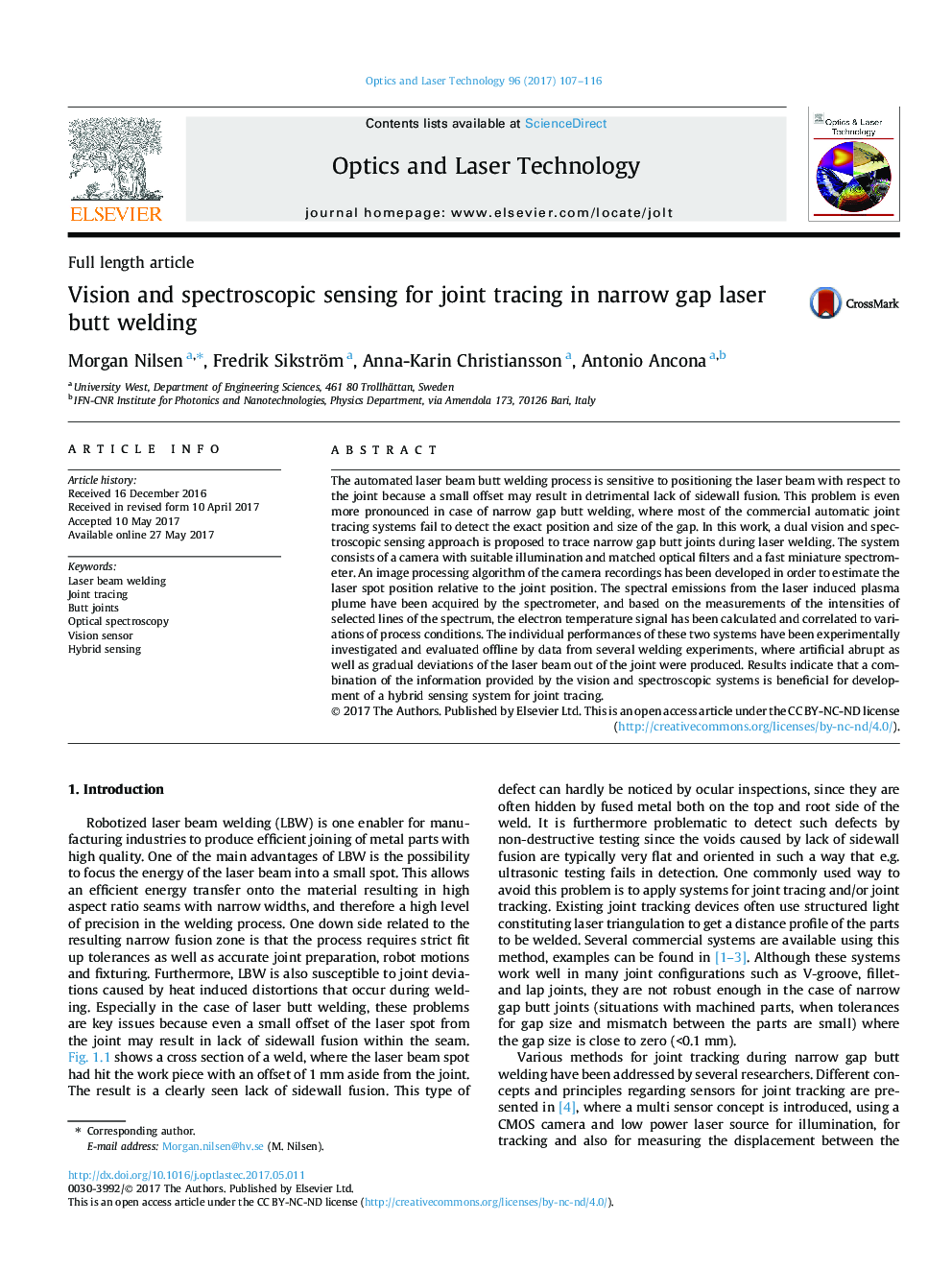| کد مقاله | کد نشریه | سال انتشار | مقاله انگلیسی | نسخه تمام متن |
|---|---|---|---|---|
| 5007194 | 1461603 | 2017 | 10 صفحه PDF | دانلود رایگان |
عنوان انگلیسی مقاله ISI
Vision and spectroscopic sensing for joint tracing in narrow gap laser butt welding
ترجمه فارسی عنوان
بینایی و حسگر طیف سنجی برای ردیابی مشترک در جوشکاری با لیزر لیبر باسن
دانلود مقاله + سفارش ترجمه
دانلود مقاله ISI انگلیسی
رایگان برای ایرانیان
کلمات کلیدی
جوشکاری پرتو لیزر، ردیابی مشترک، مفاصل لبها طیف سنجی نوری، سنسور دید حسگر ترکیبی
ترجمه چکیده
فرآیند جوشکاری با لیزر اتوماتیک با توجه به محل قرار گیری پرتو لیزر نسبت به مفصل حساس است، زیرا یک جابجایی کوچک ممکن است باعث کمبود متفاوتی از فونداسیون شود. این مسئله حتی در مواردی که جوشکاری با شکاف باریک باریک است، بیشتر جایی است که بیشتر سیستم های ردیابی مجتمع تجاری تجاری قادر به تشخیص موقعیت دقیق و اندازه شکاف نیستند. در این کار، یک روش دید دوگانه و طیف سنجی سنجش برای پیش بینی اتصالات مفاصل انحنای محدود در طی جوشکاری لیزر پیشنهاد شده است. این سیستم شامل یک دوربین با نور مناسب و فیلترهای نوری همگرا و طیف سنج سریع مینیاتوری است. یک الگوریتم پردازش تصویر از ضبط های دوربین برای تخمین موقعیت نقطه لیزری نسبت به موقعیت مشترک طراحی شده است. انتشار طیفی از شعله پلاسما القایی با طیف سنج به دست آمده است و براساس اندازه گیری شدت های خطوط انتخاب شده طیف، سیگنال دمای الکترونی محاسبه شده و با تغییرات شرایط فرآیند محاسبه شده است. عملکرد فردی این دو سیستم با استفاده از داده های چندین آزمایش جوش داده شده به صورت آزمایشی مورد بررسی قرار گرفته و به صورت آفلاین ارزیابی شده است، در حالیکه انفجار مصنوعی و همچنین انحرافات تدریجی پرتو لیزر از مفصل تولید می شود. نتایج نشان می دهد که ترکیبی از اطلاعات ارائه شده توسط سیستم های بینایی و طیفی برای توسعه یک سیستم سنجش ترکیبی برای ردیابی مشترک مفید است.
موضوعات مرتبط
مهندسی و علوم پایه
سایر رشته های مهندسی
مهندسی برق و الکترونیک
چکیده انگلیسی
The automated laser beam butt welding process is sensitive to positioning the laser beam with respect to the joint because a small offset may result in detrimental lack of sidewall fusion. This problem is even more pronounced in case of narrow gap butt welding, where most of the commercial automatic joint tracing systems fail to detect the exact position and size of the gap. In this work, a dual vision and spectroscopic sensing approach is proposed to trace narrow gap butt joints during laser welding. The system consists of a camera with suitable illumination and matched optical filters and a fast miniature spectrometer. An image processing algorithm of the camera recordings has been developed in order to estimate the laser spot position relative to the joint position. The spectral emissions from the laser induced plasma plume have been acquired by the spectrometer, and based on the measurements of the intensities of selected lines of the spectrum, the electron temperature signal has been calculated and correlated to variations of process conditions. The individual performances of these two systems have been experimentally investigated and evaluated offline by data from several welding experiments, where artificial abrupt as well as gradual deviations of the laser beam out of the joint were produced. Results indicate that a combination of the information provided by the vision and spectroscopic systems is beneficial for development of a hybrid sensing system for joint tracing.
ناشر
Database: Elsevier - ScienceDirect (ساینس دایرکت)
Journal: Optics & Laser Technology - Volume 96, 1 November 2017, Pages 107-116
Journal: Optics & Laser Technology - Volume 96, 1 November 2017, Pages 107-116
نویسندگان
Morgan Nilsen, Fredrik Sikström, Anna-Karin Christiansson, Antonio Ancona,
